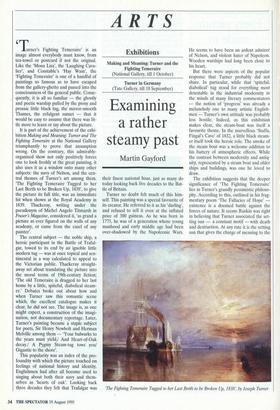ARTS
Exhibitions
Making and Meaning: Turner and the Fighting Temeraire (National Gallery, till 1 October)
Turner in Germany (Tate Gallery, till 10 September)
Examining a rather steamy past
Martin Gayford
Turner's Fighting Temeraire' is an image almost everybody must know, from tea-towel or postcard if not the original. Like the 'Mona Lisa', the 'Laughing Cava- lier', and Constable's 'Hay Wain', the 'Fighting Temeraire' is one of a handful of paintings so famous as to have escaped from the gallery-ghetto and passed into the consciousness of the general public. Conse- quently, it is all so familiar — the ghostly and poetic warship pulled by the prosy and prosaic little black tug, the mirror-smooth Thames, the refulgent sunset — that it would be easy to assume that there was lit- tle more to learn or say about the picture.
It is part of the achievement of the exhi- bition Making and Meaning: Turner and The Fighting Temeraire at the National Gallery triumphantly to prove that assumption wrong. On the contrary, this admirably- organised show not only positively forces one to look freshly at the great painting, it also uses it as a window onto many other subjects: the navy of Nelson, and the cen- tral themes of Turner's art among them. 'The Fighting Temeraire Tugged to her Last Berth to be Broken Up, 1838', to give the picture its full title, was an immediate hit when shown at the Royal Academy in 1839. Thackeray, writing under the pseudonym of Michel Angelo Titmarsh in Fraser's Magazine, considered it, 'as grand a picture as ever figured on the walls of any academy, or came from the easel of any painter'.
The central subject — the noble ship, a heroic participant in the Battle of Trafal- gar, towed to its end by an ignoble little modern tug — was at once topical and sen- timental in a way calculated to appeal to the Victorian public. Thackeray straight- away set about translating the picture into the moral terms of 19th-century fiction; 'The old Temeraire is dragged to her last home by a little, spiteful, diabolical steam- er.' Debates broke out about how and when Turner saw this romantic scene which, the excellent catalogue makes it clear, he did not see. The image is, as one might expect, a construction of the imagi- nation, not documentary reportage. Later, Turner's painting became a staple subject for poets, Sir Henry Newbolt and Herman Melville among them — 'Your bulwarks to the years must yield,/ And Heart-of-Oak decay./ A Pygmy Steam-tug tows you/ Gigantic to the shore'.
This popularity was an index of the pro- foundity with which the picture touched on feelings of national history and identity. Englishmen had after all become used to singing about both their navy and them- selves as 'hearts of oak'. Looking back three decades they felt that Trafalgar was their finest national hour, just as many do today looking back five decades to the Bat- tle of Britain.
Turner no doubt felt much of this him- self. This painting was a special favourite of its creator. He referred to it as his 'darling', and refused to sell it even at the inflated price of 300 guineas. As he was born in 1775, he was of a generation whose young manhood and early middle age had been over-shadowed by the Napoleonic Wars. He seems to have been an ardent admirer of Nelson, and violent hater of Napoleon. Wooden warships had long been close to his heart.
But there were aspects of the popular response that Turner probably did not share. In particular, while that 'spiteful, diabolical' tug stood for everything most detestable in the industrial modernity in the minds of many literary commentators — the notion of 'progress' was already a melancholy one to many artistic English- men — Turner's own attitude was probably less hostile. Indeed, as this exhibition makes clear, the steam-boat was itself a favourite theme. In the marvellous `Staffa, Fingal's Cave' of 1832, a little black steam- er itself took the heroic role. The smoke of the steam boat was a welcome addition to his battery of atmospheric effects. While the contrast between modernity and antiq- uity, represented by a steam boat and older ships and buildings, was one he loved to draw.
The exhibition suggests that the deeper significance of 'The Fighting Temeraire' lies in Turner's grandly pessimistic philoso- phy. According to this, outlined in his frag- mentary poem 'The Fallacies of Hope' — existence is a doomed battle against the forces of nature. It seems Ruskin was right in believing that Turner associated the set- ting sun — a constant motif — with death and destruction. At any rate it is the setting sun that gives the charge of meaning to the 'The Fighting Temeraire Tugged to her Last Berth to be Broken Up, 1838', by Joseph Turner 'Fighting Temeraire', though, in prosy real- ity, no 19th-century mariner in his right mind would have risked docking such a valuable bit of salvage in failing light.
There are many sunsets to be seen in Turner in Germany, too, the latest of the Tate Gallery's topographical displays of Turner's watercolours. Most extraordinary are the three studies from 1841 of Ehren- breitstein — site of a heroic action in the Napoleonic Wars — in which the moun- tain is respectively lemon yellow, shell pink and palest orange. This little exhibition follows the artist in his indefatigable jour- neys on the Elbe, Rhine, Neckar, and Danube. It forms a useful supplement to the National Gallery exhibition, and it too has an excellently illustrated and researched catalogue.



















































 Previous page
Previous page